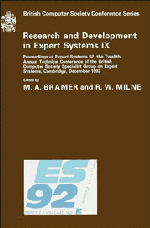Book contents
- Frontmatter
- Contents
- Preface
- Introduction
- CONSULTANT: providing advice for the machine learning toolbox
- A methods model for the integration of KBS and conventional information technology
- KBS methodology as a framework for co-operative working
- Project management for the evolutionary development of expert systems
- The specification and development of rule-based expert systems
- Towards a method for multi-agent system design
- Jigsaw: configuring knowledge acquisition tools
- On the relationship between repertory grid and term subsumption knowledge structures: theory practice tools
- Strategy maze: an on-line tool for support management of the knowledge acquisition process
- Concurrent engineering using collaborating truth maintenance systems
- Ockham's razor as a gardening tool
- A designer's consultant
- Fairness of attribute selection in probabilistic induction
- An application of case-based expert system technology to dynamic job-shop scheduling
- Neural network design via LP
- KEshell2: an intelligent learning data base system
- Approaches to self-explanation and system visibility in the context of application tasks
- An object oriented approach to distributed problem solving
- Intelligent user interface for multiple application systems
- Combining qualitative and quantitative information for temporal reasoning
- Documents as expert systems
Neural network design via LP
Published online by Cambridge University Press: 04 August 2010
- Frontmatter
- Contents
- Preface
- Introduction
- CONSULTANT: providing advice for the machine learning toolbox
- A methods model for the integration of KBS and conventional information technology
- KBS methodology as a framework for co-operative working
- Project management for the evolutionary development of expert systems
- The specification and development of rule-based expert systems
- Towards a method for multi-agent system design
- Jigsaw: configuring knowledge acquisition tools
- On the relationship between repertory grid and term subsumption knowledge structures: theory practice tools
- Strategy maze: an on-line tool for support management of the knowledge acquisition process
- Concurrent engineering using collaborating truth maintenance systems
- Ockham's razor as a gardening tool
- A designer's consultant
- Fairness of attribute selection in probabilistic induction
- An application of case-based expert system technology to dynamic job-shop scheduling
- Neural network design via LP
- KEshell2: an intelligent learning data base system
- Approaches to self-explanation and system visibility in the context of application tasks
- An object oriented approach to distributed problem solving
- Intelligent user interface for multiple application systems
- Combining qualitative and quantitative information for temporal reasoning
- Documents as expert systems
Summary
INTRODUCTION
Examples of the pattern classification problem (known variously as: pattern recognition, discriminant analysis, and pattern grouping) are widespread. In general such problems involve the need to assign objects to various groups, or classes, and include such applications as: (i) the assignment of production items to either defective or non-defective classes as based upon the results of tests performed on each part, (ii) the assignment of personnel to jobs as based upon their test scores and/or physical attributes, (iii) the assignment of an object detected by radar to either a friendly or unfriendly category, (iv) the categorization of investment opportunities into those that are attractive and those that are not, and so on. Early (scientific) efforts to model and solve the pattern classification problem utilized, for the most part, statistical approaches. In turn, these approaches usually rely upon the somewhat restrictive assumptions of multivariate normal distributions and certain types of (and conditions on) covariance matrices. More recent attempts have employed expert systems, linear programming (LP) and, in particular, neural networks. In this paper, we describe the development of an approach that combines linear programming (specifically, traditional linear programming and/or linear goal programming [Ignizio, 1982]) with neural networks, wherein the combined technique is itself monitored and controlled by an expert systems interface.
More specifically, we describe the use of expert systems and linear programming in the simultaneous design and training of neural networks for the pattern classification problem.
- Type
- Chapter
- Information
- Research and Development in Expert Systems IX , pp. 237 - 252Publisher: Cambridge University PressPrint publication year: 1993



